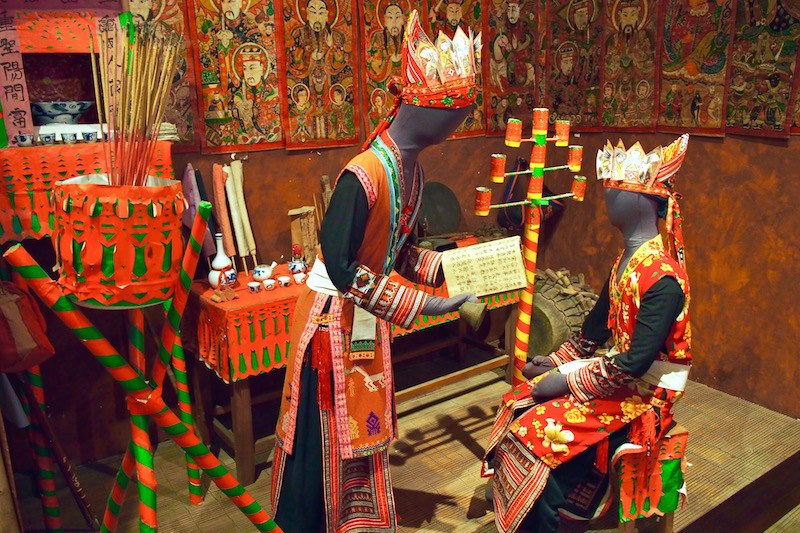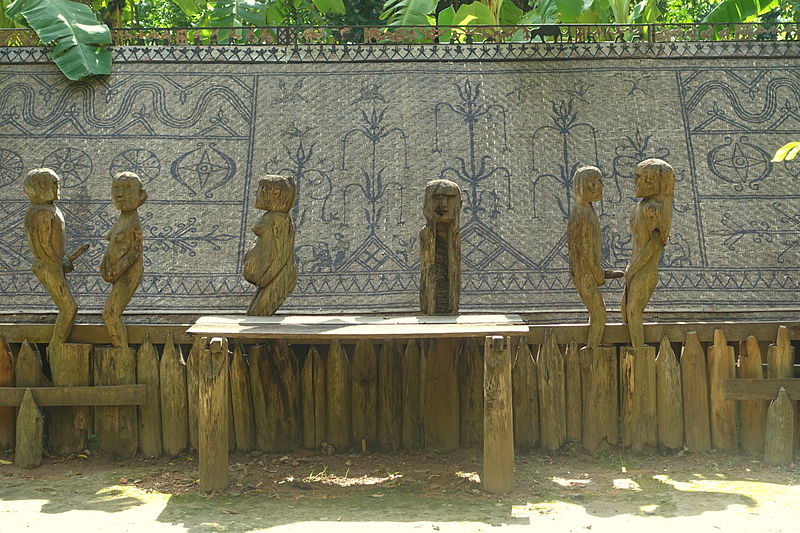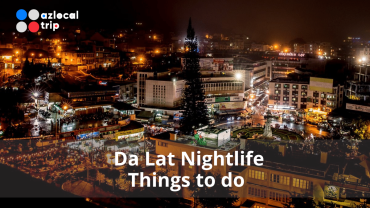Vietnam Museum of Ethnology is definitely your cup of tea if you are those who are keen to learn about the multicultural features of Vietnam and those who appreciate an environmentally-friendly space.
Being regarded as a center for ethnographic research, Vietnam Museum of Ethnology in Hanoi offers an insight into the 54 different ethnic groups throughout Vietnam, the S-shaped country.
Vietnam Museum of Ethnology Hanoi Introduction
Table of Contents
- Location: Nguyen Van Huyen Street, Quan Hoa, Cau Giay, Ha Noi
When was the construction project of the Museum of Ethnology carried out?
Vietnam is known as a multi-ethnic country with a harmonious combination of 54 ethnic groups.
In a tremendous effort to preserve cultural heritage and promote socio-cultural diversity within the country, the Vietnamese Government decided to establish an ethnographic museum in Hanoi.
The proposal for the Vietnam Museum of Ethnology was officially approved on 14 December 1987.
Thanks to the first investment from the government in 1986, the construction of the foundation began in late 1989.
> Explore 54 ethnic groups of Vietnam in Hanoi Museum FREE Tour with local students
Vietnam Museum of Ethnology Entrance Fee
- Adult: 40.000 VND/each ( ≈1.8 USD)
- Students, the elderly and the disabled: 15,000 VND (ID, students card required)
- Children under the age of 15: Free
Vietnam Museum of Ethnology Opening Hours
- Daily except for Monday and Lunar New Year Eve
- Open at 08:00 a.m and close at 5:30p.m
What is the Achievement of the Ethnology Museum Hanoi?
The Museum ranked in the sixth position in a list of 25 most fascinating museums in Asia according to TripAdvisor.
Vietnam Museum of Ethnology received 500 excellent ratings, 375 good ratings (4.5 stars).
> TripAdvisor ranked the Museum in the 4th position of 95 Hanoi attractions list.
What is the Essential Role of the Hanoi Museum of Ethnology?
Vietnam Museum of Ethnology is a convergence of cultures and a scientific ethnological center.
Being a member of the National Centre for Social Sciences and Humanities, the museum participates in various undertakings.
- Implement scientific research on Vietnamese nationalities, collection, classification, assessment, preservation, restoration and so on.
- Exploit the cultural and historical patrimony of all Vietnamese ethnic communities.
The museum boasts more than 15.000 artifacts
Approximately 40.000 photographs and many audio-visual tapes
Many collections of high cultural value are exhibited and preserved by the museum.
>>> Top and Tips for Hanoi Museum 2019 <<<
What is the architecture of the museum like?
The exhibition building was designed based on the idea of the architect Ha Duc Linh, a Tay minority, in the shape of a Đong Son drum.
Dong Son drum, also called Heger Type I drum- A bronze drum fabricated by the Dong Son culture in the Red River Delta of northern Vietnam.
The French architect Véronique Dollfus continued to design the interior architecture.
- The museum is divided into two main parts: an indoor exhibition and an outdoor one.
The indoor part of Ethnology Museum Hanoi
It includes the exhibition building, office, research center, library, storage, technical lab, and auditorium.

A corner of the indoor exhibition in Vietnam Museum of Ethnology
Hundreds of common objects using in daily activities were displayed.
Goods made from various types of fabric by different ethnic groups such as skirts, scarves, and clothes were decorated with various traditional techniques.
Other manmade products include baskets, trays, musical instruments made from bamboo, calabashes, ritual artifacts, and so on.
Along with the traditional objects, tourists can discover documents and photographs reflecting all aspects of tangible as well as intangible culture in daily life and the creativity of minorities.
The Second Floor of Hanoi Ethnology Museum
The showpieces are displayed depending on geographical locations and languages, into nine groups with a close link with each other.
Temporary exhibitions are always renewed according to the exhibition’s topics.
“Life in Hanoi during the subsiding period (1975-1986)” in 2006
The exhibition of students’ life away from home in big cities in 2013
The series of photos of life of Tay Nguyen ethnics in the 1950s in 2014 and 2015.
The outdoor exhibition at Museum of Ethnology Hanoi
It was accomplished in the first year of the 21st century.
Most of the space of the 2-storey is reserved for long-term and regular display of objects and documents about the cultural characteristics and the outlook of Vietnamese communities.
-
Outdoor section – The Garden of Architecture
The outdoor area of the museum attracts tourists to a host of houses modeling after the traditional architecture of ethnic minorities, especially those who live in the Northern and Central Highlands.
Visitors can learn more about the diversity of perspectives traditions and living styles of various ethnics.
-
Giarai Arap group
Giarai Arap community inhabited in Giarai, Kon Tum (mainly) and the north of Daklak province.
As Giarai people hold the deceased in high esteem, the Giarai has the tradition of building large tombs to worship the passed away.
Giarai tombs to worship the passed away
The most prominent decorations on the Giarai tombs are 27 carvings made from wooden tree trunks using adzes, cutlasses, and knives.
Carvings of sexually- explicit men and women and expectant mothers symbolize fertility and birth.

Carvings of sexually – explicit men and women
Other carvings are of seated children (often placed on the forth corners), animals, people-the “servants” of the dead in the afterlife.
Giarai toms are the biggest ones compared to other ethnic groups with a size of 45 square meters.
These toms are considered as a symbol of the exemplary architecture of the group.
>>> FREE ITINERARY PLANNING for days in Hanoi <<<
-
Cham House
House is the most tangible cultural heritage of the Cham with different physical characteristics:
The Cham built houses on the ground and arranged them in ordered rows.
Doors open to the south-west or between.
Walls made of bricks and a mixture of lime and shells, covered with tiles or thatches. (Similar to the architecture of Viet houses)
Rooms are arranged in a particular order: Sitting room, Room for parents, Children and married women, Kitchen, Warehouse, Nuptial room for the youngest daughter.
This arrangement reflects the break-up of the matrilineal extended family system.
Certain rituals must be performed before the building of the house to pray for the Land God and ask for his permission to cut down trees in the forest.
-
Viet House
The North and Middle of Vietnam are frequently hit by storms and hurricanes, local residents content themselves with one story houses.
Middle bay in the main house is the altar of ancestors.
Two lateral bays are the place for visitors and the rest for family members.
Vietnamese yards are built by traditional bamboo and wood structures.
In the 20th centuries, 5 bays were joined on the main house to serve initially as a nice loft, and later as where tuition was given.
-
Ede Long House
The longhouse (Nha dai) in Buon Don District, Dak Lak, belonging to the Ede ethnic group, is the longest house in the Central Highlands with 85m long and 6m wide.
“Nha dai” serves as a community hall for public meetings and communal activities of the Ede.

“Nha dai” of the museum built in 2002 with a thatched roof and more than 1000 three-meter planks
Ede longhouses are not only a maternal embodiment of the matriarchy but also a place in which cultural and spiritual value of the Ede and the Central Highlands is preserved.
In the early years of the 20th century, the powerful commune became the heart of the vast Central Highlands. These houses are long enough for dozens of members to live in.
The longhouses are always divided into three parts:
Two verandas attached to each house
+ Front (dring gah): Very large, used to sundry the family’s harvest, prepare for meals in the morning and rest in the afternoon.
+ Back (dring ok): Smaller, to provide space for the bathroom and kitchen.
Visitor’s corner (gah):
+ Occupy from one-third to half of the total space
+ The place to welcome visitors and for the common activities of the large family
+ Visitors can observe priceless and holy objects like drums, gongs, and antlers.
Next to gah is bedrooms (ok) for branch families along the aisle leading to the back veranda.
- Bana Communal House – The most important building of Bana village
Communal houses serve as meeting halls for male, rituals, celebrations, preparation for war.
This house was built after the model of the 20th-century communal house of Kon Rbang which maintains the traditional system of the building with poles and beams.
The wood, bamboo, rattan, and straw were brought from the Central Highlands.
With the aid of 29 Bahnar people, the house in the museum was fully completed on June 4, 2003.
-
Thủy Đình House
The folk tradition is also shown through the art of water puppet in Thủy Đình House.
As a traditional art form, the story about rural life is told through the combination of wooden puppet and traditional musical playing on the water.
- Southeast Asia section- “Cánh Diều” (the Kite) building
In 2007, a 4-storey building named “Cánh Diều” (the Kite) built the third exhibition booths of the museum with the area of 500ha
The objectives are to introduce foreign cultures, mainly the cultures of nations in Southeast Asia.
- Visual Performance is pregnant with Southeast Asia Culture
The Java play of mask and dance
The Java people in Indonesia has the tradition of dancing play since the 15th centuries.
Actors wear masks and are guided the storyteller script, with the assist of Gamelan (A traditional musical instrument).
Indonesia Shadow Puppet
The art of shadow puppet (wayang kulit) is originated from India.
Actors perform the play of delicate puppet on a white background.
Myanmar String Puppet (yoke thay thabin)
This art was born since the 15th centuries and it reached the peak of its popularity in the 19th centuries in Myanmar.
The play is based on the familiar folk of Budda, the myth of the birth of the world and historical tales.
A performance of Myanmar String Puppet
In the play, the evil puppets walk from the left, princess, prince and king puppets walk from the right; and the magical puppets fly down from the sky











Comment (0)